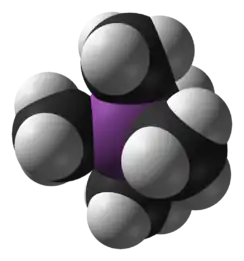Pentamethylbismuth
Pentamethylbismuth (or pentamethylbismuthorane[2]) is an organometalllic compound containing five methyl groups bound to a bismuth atom with formula Bi(CH3)5. It is an example of a hypervalent compound. The molecular shape is trigonal bipyramid.[3]
 | |
| Names | |
|---|---|
| Systematic IUPAC name
pentamethyl-λ5-bismuthane | |
| Identifiers | |
3D model (JSmol) |
|
PubChem CID |
|
| |
| |
| Properties | |
| C5H15Bi | |
| Molar mass | 284.155 g·mol−1 |
| Appearance | blue-violet solid |
| Related compounds | |
Related compounds |
Trimethylbismuth Pentamethylarsenic Pentamethylantimony Pentamethyltantalum Pentaphenylbismuth |
Except where otherwise noted, data are given for materials in their standard state (at 25 °C [77 °F], 100 kPa). | |
| Infobox references | |
Production
Pentamethylbismuth is produced in a two step process. First, trimethylbismuth is reacted with sulfuryl chloride to yield dichloro trimethylbismuth, which is then reacted with twice as much methyllithium dissolved in ether.[4] The blue solution is cooled to −110 °C to precipitate the solid product.
- Bi(CH3)3 + SO2Cl2 → Bi(CH3)3Cl2 + SO2
- Bi(CH3)3Cl2 + 2LiCH3 → Bi(CH3)5 + 2LiCl
Properties

At -110 °C, Bi(CH3)5 is a blue-violet solid. The methyl groups are arranged in a trigonal bipyramid, and the bond-lengths of methyl with bismuth are all the same. However, the molecule is not rigid, as can be determined from the nuclear magnetic resonance spectrum that shows all methyl groups are equivalent.[4] It is stable as a solid, but in the gas phase, when heated or in solution decomposes to trimethylbismuth.[3][4] The colour is unusual for bismuth or other hypervalent pnictide compounds, which are colourless. Calculations show that the colour is due to HOMO-LUMO transition. The HOMO is ligand based, whereas the LUMO is modified by relativistically stabilised bismuth 6s orbitals.[5]
Reactions
If excess methyllithium is used in production, an orange hexamethylbismuth salt, LiBi(CH3)6, is formed .[6] This is unusual as very few elements can form bonds with six organic groups.[4]
References
- Urben, Peter (2013). Bretherick's Handbook of Reactive Chemical Hazards. Academic Press. p. 742. ISBN 9780080523408.
- Hellwinkel, Dieter (1883). "Penta- and hexaorganyl derivatives of the main group five elements". Wittig Chemistry. Topics in Current Chemistry. Topics in Current Chemistry. 109: 1–63. doi:10.1007/BFb0018055. ISBN 3-540-11907-8.
- Greene, Tim M.; Downs, Anthony J.; Pulham, Colin R.; Haaland, Arne; Verne, Hans Peter; Volden, Hans Vidar; Timofeeva, Tatjana V. (November 1998). "Molecular Structures of Pentamethylarsenic(V) and Trimethyldichloroarsenic(V) by Gas Electron Diffraction and ab Initio Calculations:? Molecular Mechanics Calculations on Pentamethylarsenic(V), Pentaphenylarsenic(V), and Related Compounds". Organometallics. 17 (24): 5287–5293. doi:10.1021/om980520r.
- Wallenhauer, Stephan; Seppelt, Konrad (18 May 1994). "Methylbismuth(V) Compounds". Angewandte Chemie International Edition in English. 33 (9): 976–978. doi:10.1002/anie.199409761.
- Conradie, Jeanet; Ghosh, Abhik (February 2017). "The Blue-Violet Color of Pentamethylbismuth: A Visible Spin-Orbit Effect". ChemistryOpen. 6 (1): 15–17. doi:10.1002/open.201600131. PMC 5288750. PMID 28168144.

- Wallenhauer, Stephan; Seppelt, Konrad (January 1995). "Antimony(V) and Bismuth(V) Methyl Compounds: A Structural Comparison". Inorganic Chemistry. 34 (1): 116–119. doi:10.1021/ic00105a021.
Extra reading
- Gagnon, Alexandre; Dansereau, Julien; Le Roch, Adrien (2 March 2017). "Organobismuth Reagents: Synthesis, Properties and Applications in Organic Synthesis". Synthesis. 49 (8): 1707–1745. doi:10.1055/s-0036-1589482.
